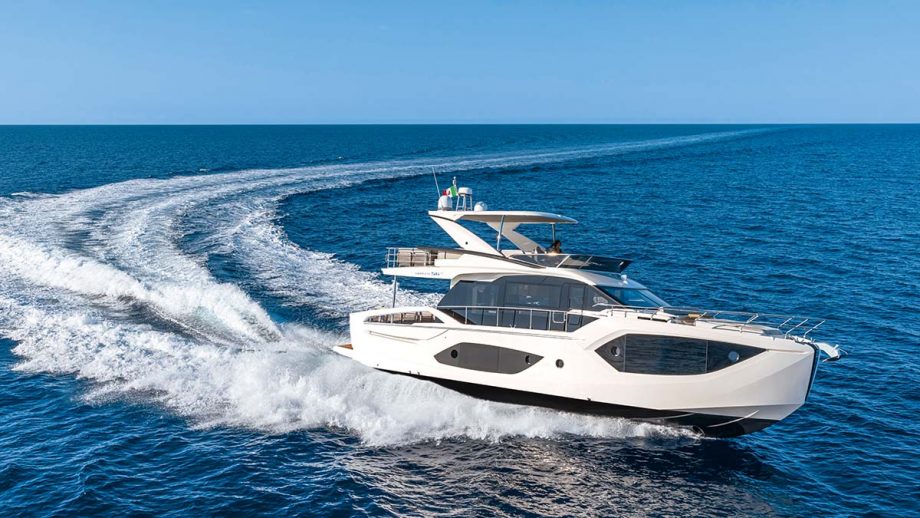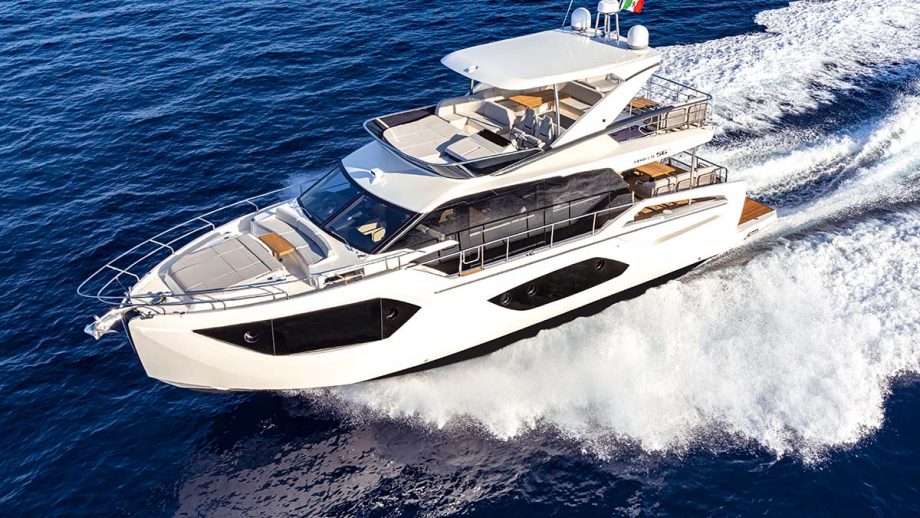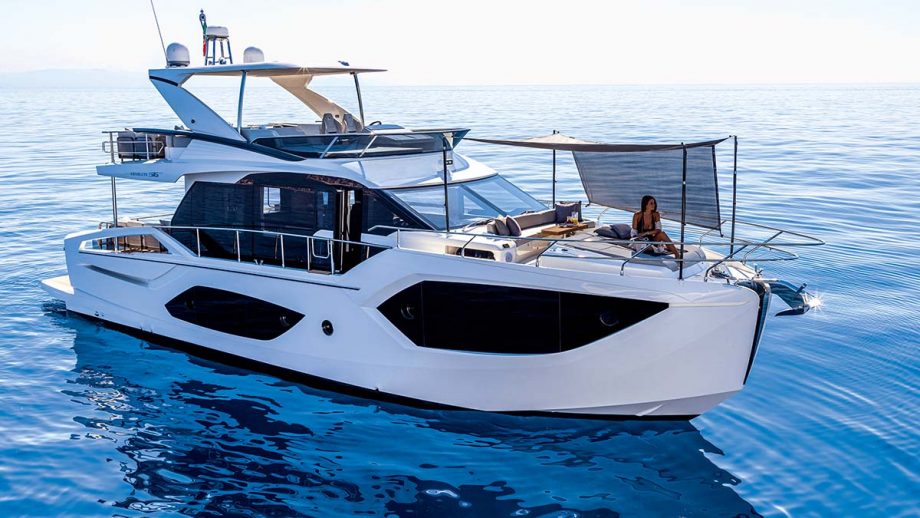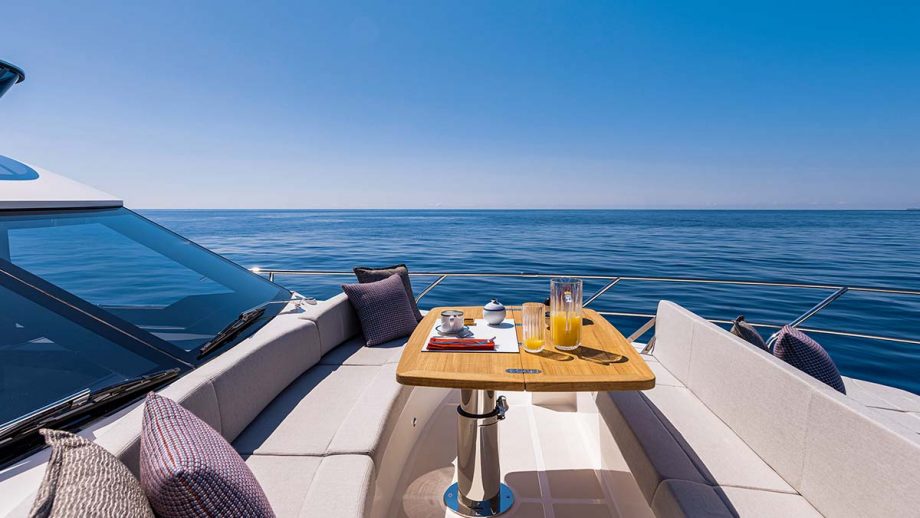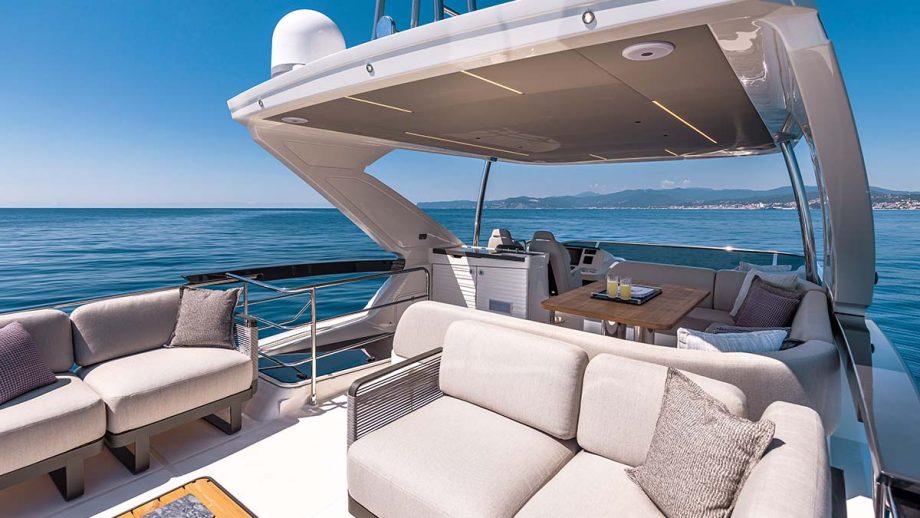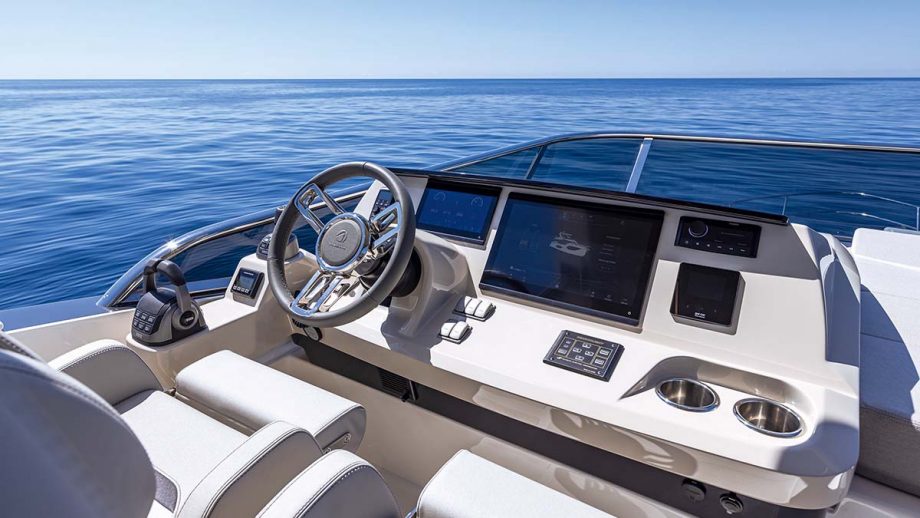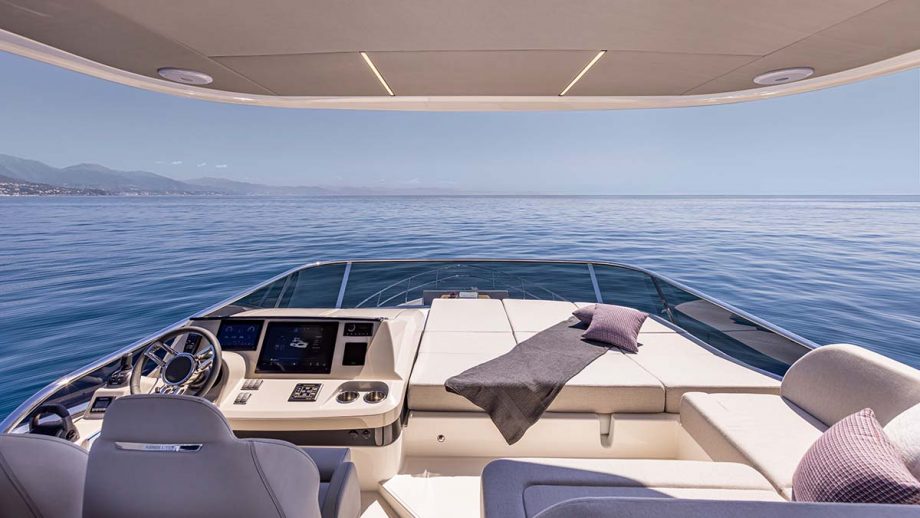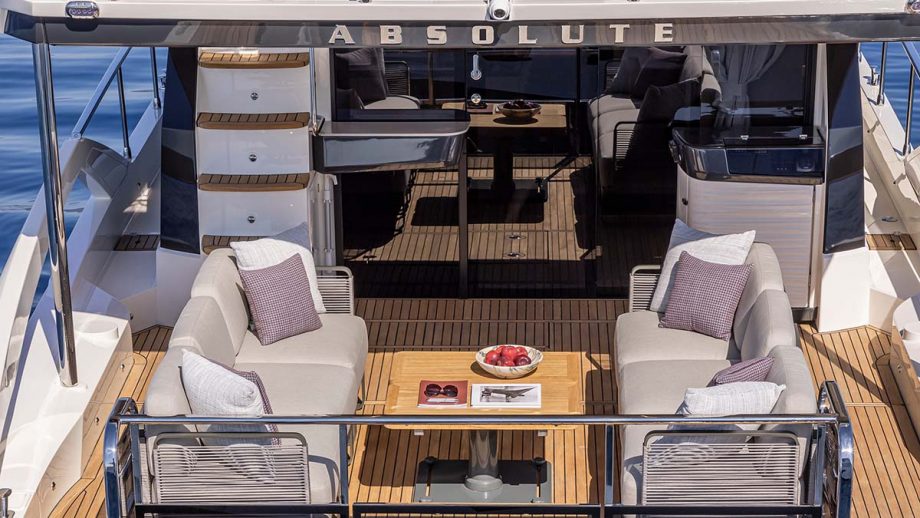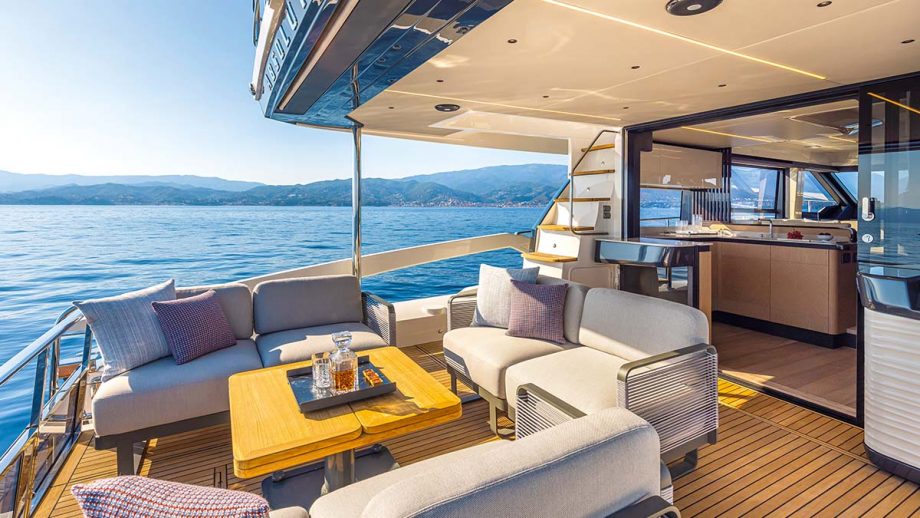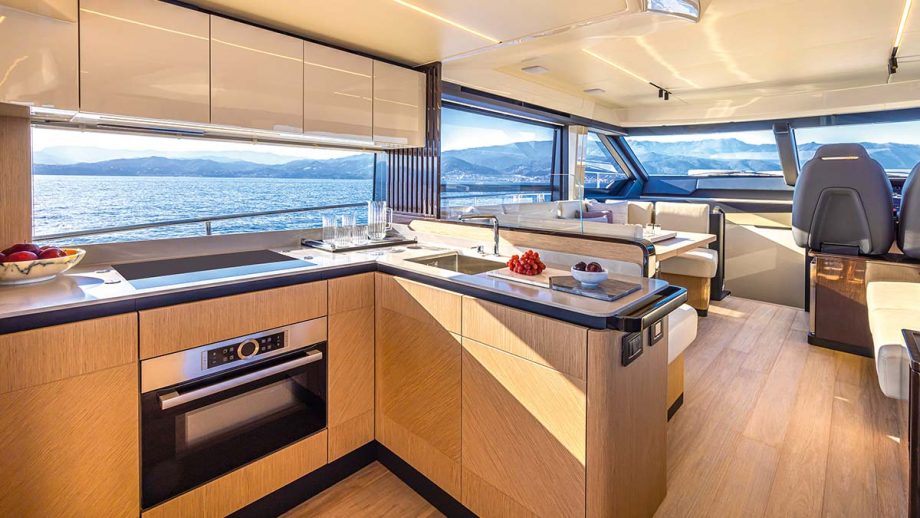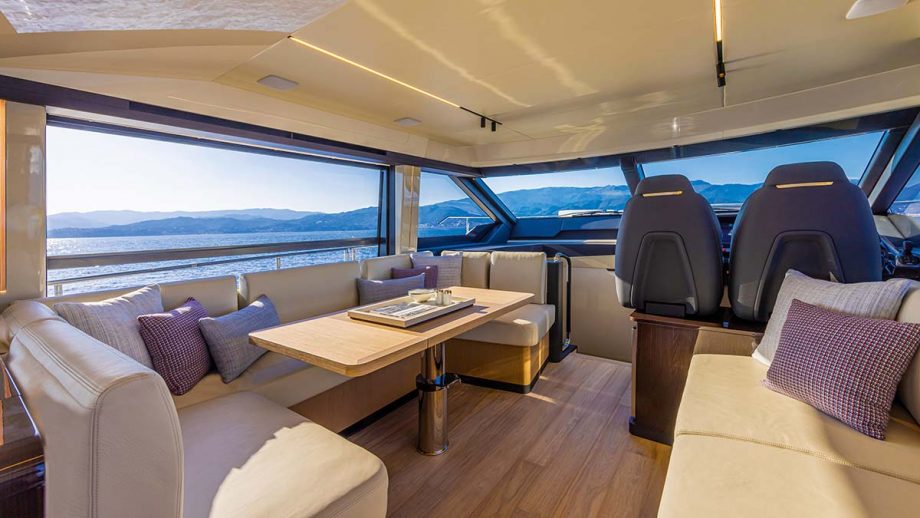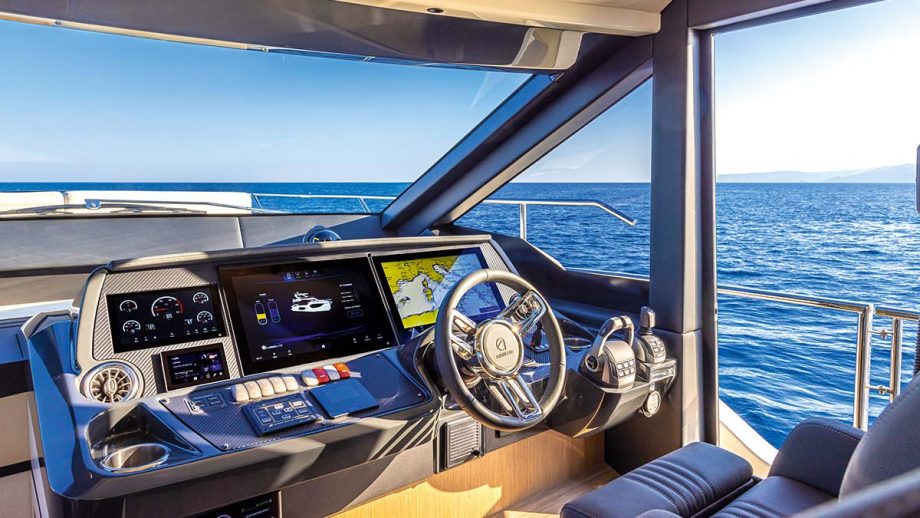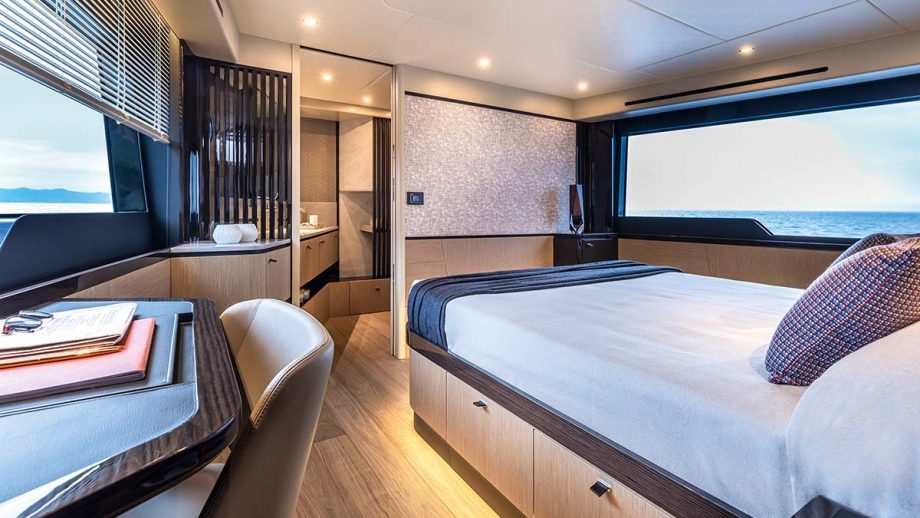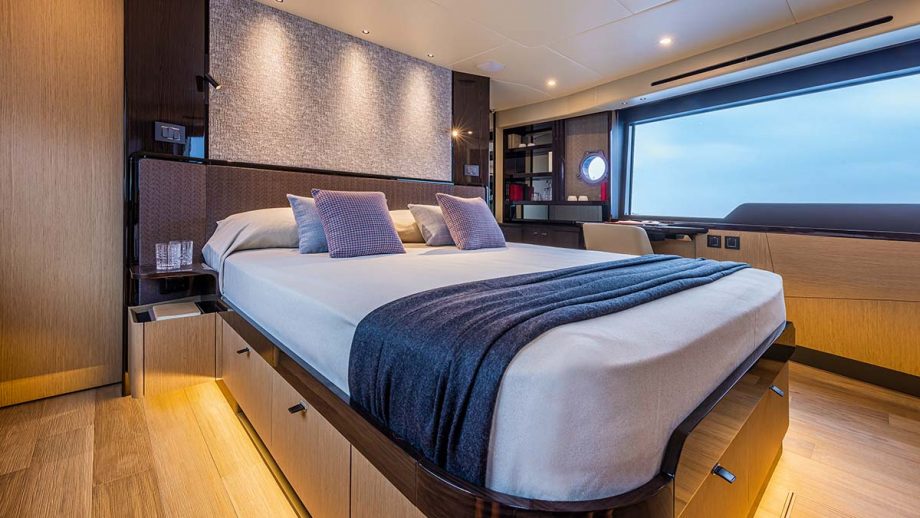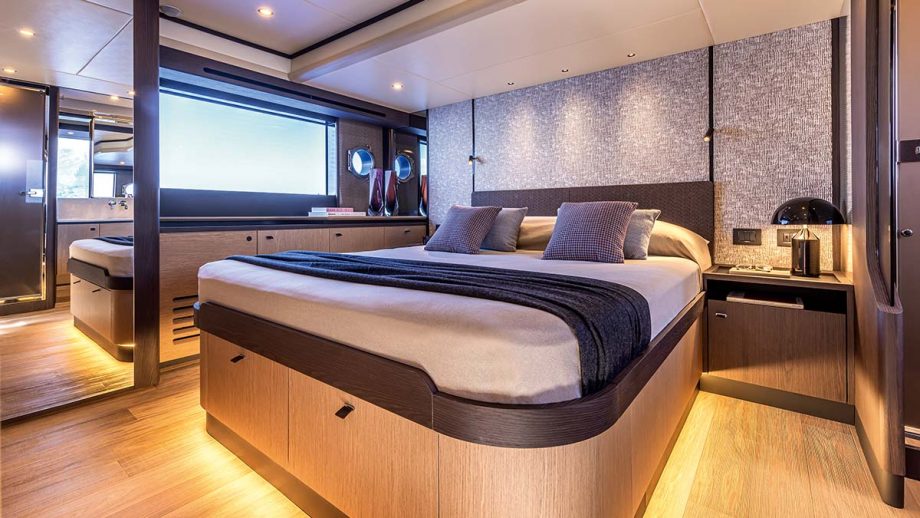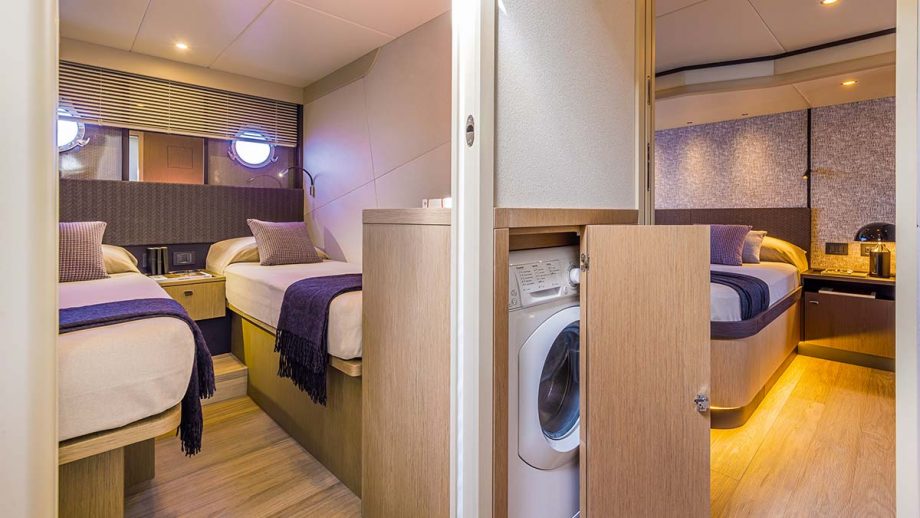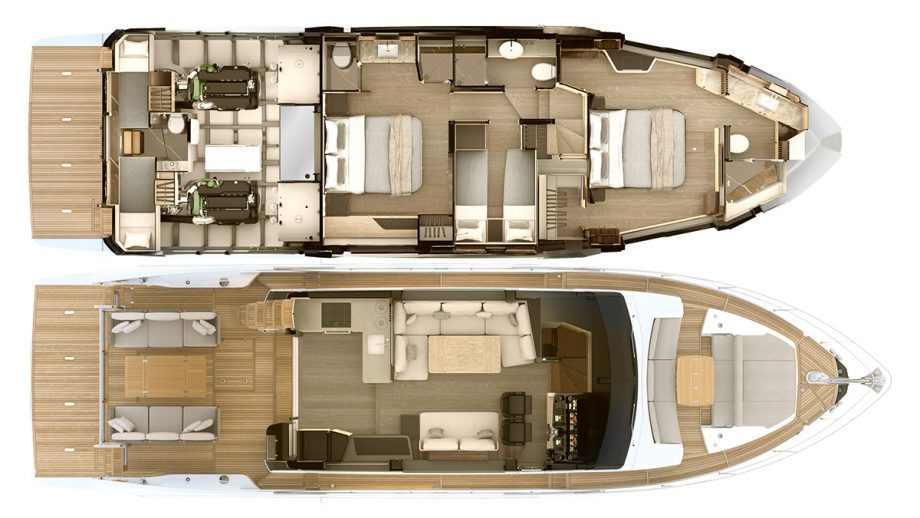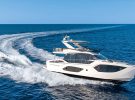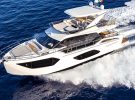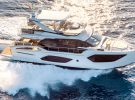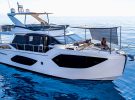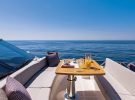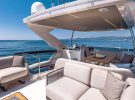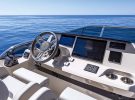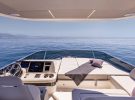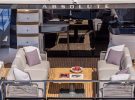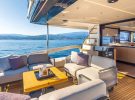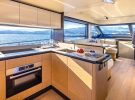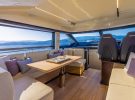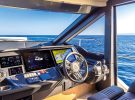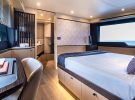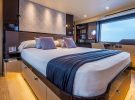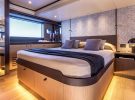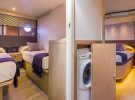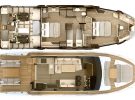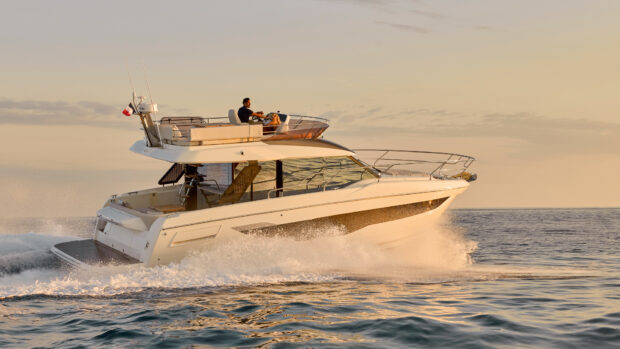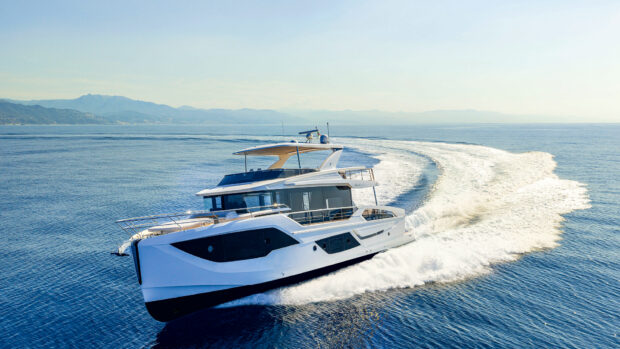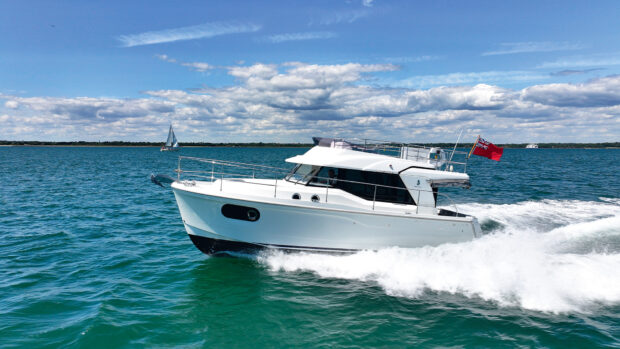The all-new Absolute 56 Fly is not the fastest flybridge motoryacht in its size segment but it has bags of style and is one of the best in terms of space utilisation…
Slotting neatly between last season’s Absolute 60 Fly and the soon-to-come Absolute 52 Fly, the all-new Absolute 56 Fly has a lot going for it.
The design is typically Absolute – bold, distinctive and instantly recognisable. With its snub-nosed bow, big hull windows, cutaway bulwarks and unusual chopped stern with a slight reverse rake (which perversely enhances the perception of length), the Absolute 56 Fly stands out, even in this hotly contested sector.
What little transom there is stops at deck height, topped by a half-height glazed balustrade and a stainless steel guardrail with side gates to separate the aft cockpit from the oversized hydraulic bathing platform a couple of steps below.
Like the cutaway bulwarks, it’s all about opening up the views, strengthening the connection with the water and helping foster a genuine beach club vibe.
Like the expansive flybridge above, that ‘cockpit terrace’ is left deliberately bare so that owners can pick and mix from a range of Terraforma modular deck furniture that has been designed for Absolute.
Article continues below…

Absolute 50 Fly review: From the archives
£694000

Sunseeker Manhattan 55 review: How do you improve a £1m winning formula?
They can also buy whatever they want from other sources of course but, being relatively heavy, the Absolute furniture doesn’t tend to shift around of its own accord.
That said it can look a bit untidy if chairs are left out of position by guests at the end of the day and off season, you would probably want to store it inside to protect it form the weather.
Elsewhere, it’s good to see that the flybridge hardtop option includes built-in solar panels with a 1.5kW peak power capability. In addition to the batteries, that’s enough to cope with normal daytime electrical demands, as long as you don’t need to use your air-conditioning.

A range of freestanding furniture options are available for the flybridge
That makes for a cleaner, quieter life aboard because you don’t always have to run the generator at anchor or even connect to shore power when berthed.
Internal refinements
The main saloon includes a well appointed aft galley with views to port between the overhead cupboards and the work surface. It also includes a very comfortable amidships lounge/dinette area, plus a very handy side door for the skipper.
The owner also gets to choose whether to have one or two bucket seats at the starboard helm console. Either way, thanks to the Absolute’s cutaway bulwarks, those picture windows to either side deliver fabulous views out and let masses of light in.

The skipper’s door makes access to the side decks very straightforward
They’re also all the better for having big centre sections that drop down to provide more fresh air as and when required – and that’s vital when operating in the ‘quiet mode’ with the AC off.
In terms of the ambience, light and dark stained oak veneers and a mix of matt and satin finishes create a calm and contemporary décor. There are no other veneer choices.
The sole is oak as well but it comes with a useful non-slip treatment. The same can also be chosen for the cabins, helping bring some extra style and modernity to the standard-fit carpeting.

The forward owner’s suite enjoys exceptional light and privacy
The forward cabin
The vast forward hull windows are the obvious giveaways as to the location of the owner’s cabin up front. It has become something of a signature feature for the Italian yard with the Absolute 47, 60 and now 56 Fly (as well as most of the Navetta range) adopting this layout.
The decision to run with a forward owner’s cabin won’t please everyone but it does have a number of advantages, as well as possible downsides.
For Absolute, space optimisation is the clinching argument. Raising the foredeck to provide full standing headroom, while simultaneously carrying the beam further forward than usual, makes for a really spacious forward owner’s cabin. But it still leaves plenty of room further aft for two generous guest cabins.

The full-beam VIP is as big as most crafts’ owner’s
There’s an amazing amount of floor space around the forward-facing king-size bed, plus a large walk-in wardrobe and stylish ensuite bathroom in the bow.
In a busy marina and moored stern-to, a forward cabin is not only going to be quieter and more private, but it will also enjoy better views and light than a full-beam mid-cabin hemmed in by boats on either side.
Similarly there should be less engine and generator noise up front, although there will be more in the way of hull slap when underway and possibly even at anchor. The other big win is that it leaves the amidships space free for a lovely full-beam VIP in the spot usually occupied by a master cabin.

The third cabin has a pair of twin beds rather than bunks
Admittedly the ensuite bathroom eats up some of the portside floor space but by leaving the washbasin and hull window open to the main cabin, while keeping the shower and head in separate cubicles, it enjoys the feel of a full-beam cabin, while occupying a slightly smaller footprint.
That leaves room for a decent-sized third cabin to starboard between the two main cabins. Featuring proper transverse twin beds rather than bunks and its own bathroom opposite that doubles as the day-head, it’s a step above most guest cabins on boats of this size.
Pocket doors are another of the ways Absolute manages to get so much out of its interiors. They not only save space but also weight and can help with sound and vibration mitigation too. The only downside to these sliding designs is that the edge pulls can be rather fiddly to open.
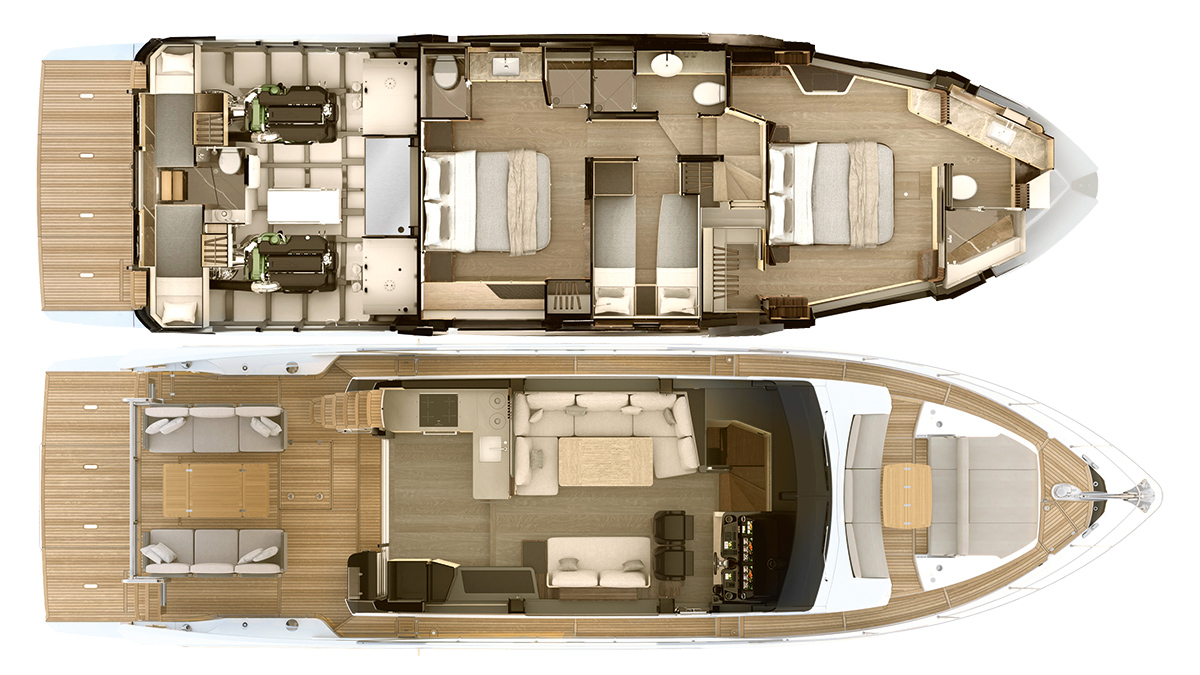
On this model all the doors, with the exception of the owner’s cabin and a service tunnel at the back of the third cabin’s wardrobe, use this sliding design. Indeed, if it weren’t for the latter’s door handle, you wouldn’t know the service tunnel was there.
Occupying the void between bilge and cabin soles, this crawl space runs all the way forward beneath the owners’ cabin to the bowthruster and has masses of deep pockets on each side that are ideal for storing the stuff you don’t need on a daily basis.
It’s a particularly useful feature so it’s good to see that several Absolute models now use it. Not that storage space is wanting elsewhere…

The cockpit’s modular furniture, and bulwarks create an intimate connection with the water
Absolute packs lockers and cupboards in wherever it can. There is a big lazarette aft, although most owners are likely to go for the crew cabin option there instead.
It’s tucked inside the transom and accessed from the stern platform via a pantograph door and half-hatch combo on the aft deck. It’s surprisingly spacious and has a pair of rectangular windows looking out over the bathing platform, making it nice and bright.
There is also room in here for two transverse berths and a head-shower compartment, from which there’s a step-through watertight door into the engine-room and hatch access from the cockpit.
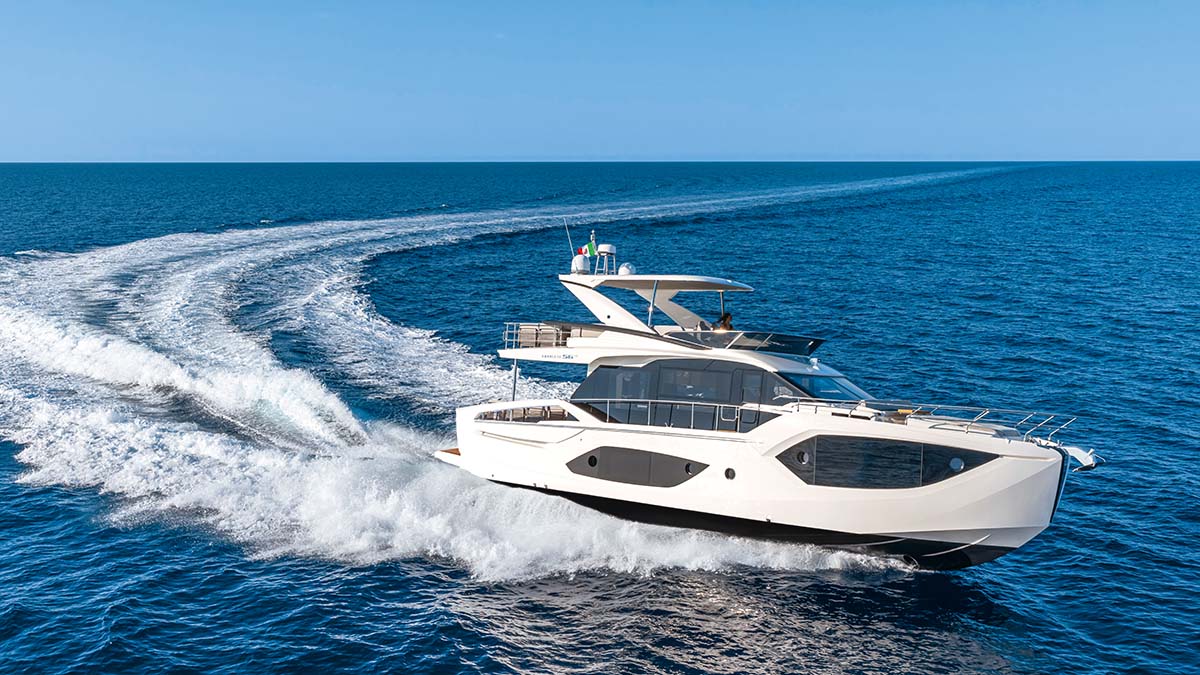
Cruising efficiency
All of Absolute’s models have Volvo Penta IPS engines and have had for years. Consequently few, if any, builders have more IPS experience than Absolute.
The Absolute 56 Fly is based on an all-new hull, albeit an evolution of various predecessors, and is propelled by twin 600hp D8 diesels and IPS800s, which provide a top speed of around 27-28 knots depending on load state.
There are no optional powertrains, which keeps things simple. Our test boat was nudging 28 knots in slight seas and with ‘Trim-Assist’ left on – not worth trying manually in normal conditions – but then we were less than half-load and missing a few of the heavier options, plus we had no tender on board.

The big forward hull windows allow fine views from the owner’s cabin
While there are certainly faster competitors out there, few are quite so flexible as regards cruising economy. Essentially the litres-per-nautical-mile curve is virtually flat from 16 knots all the way to full chat – somewhere between eight and nine litres per mile, wherever you put the throttles.
For instance, at a fast cruise of 22-23 knots, the fuel burn is around 195 lph or 8.6 litres per nm, which allowing for a 20% reserve translates to a range of 240nm.
However, you could push this to 25 or even 27 knots without significantly affecting fuel economy or range. Only if you drop the speed to 10 knots or less will the fuel burn reduce enough to give a worthwhile increase in efficiency, pushing the range to 400nm.

Both up top and down below, the helm ergonomics are spot on
We caught up with the test boat in Marina di Varazze, which is home to Absolute’s biggest Italian dealer. Alas, our test day conditions were not remotely challenging for a Cat B design, which the book says will cope with offshore passages in up to 40 knot winds and 13ft seas.
We had little of either. In these conditions it is not what you would call an exciting drive but then 50-something flybridges aren’t really meant to be. What they are meant to be is comfortable and reassuring and the 56 Fly, like the rest of the builder’s model portfolio, has both of those boxes ticked. And having tested many
Absolutes over the years we can vouch for their handling in more challenging conditions, as well as their impressively solid build quality. Both up and down, the helm station ergonomics are up to Absolute’s usual high standards. There’s close to 360° visibility at the lower helm station, despite the height of that foredeck.

Drop down windows in the saloon help reduce the need for air con
Under acceleration, the bow rises gradually to a peak of around 3.5° before dropping off half a degree at the upper reaches of the speed range. Steering is nicely responsive and turns are taken with just the right amount of heel for comfort.
Noise is well suppressed, and from what few wakes and waves we could find to test her capabilities, the ride quality appeared perfectly acceptable for this type of craft.
Price in perspective
Our test boat had the hardtop, a big generator and an uprated AC system, but there was no gyro-stabiliser, passerelle, crew cabin or Dynamic Positioning System, all of which we suspect most European owners will want.

The glass transom and oversized bathing platform help foster a beach club vibe
Add these and a few other Med-friendly options to the 56 Fly’s base price of £1.45m (ex tax) and you’re looking at around £1.7m – a price that’s in line with competing models from the likes of Sunseeker, Princess, Azimut and Ferretti.
The Absolute 56 Fly is certainly a match in terms of fit out and arguably more than a match when it comes to the size, style and functionality of its living spaces.
Price as reviewed:
£1,510,000.00 inc. VAT
Verdict
It may not be quite as dynamic to drive as its British rivals but if you’re looking for a stylish, well-built flybridge cruiser, with a wonderful forward owner’s cabin, then the Absolute 56 Fly should be on your list.
Details
Starting price: €1,450,000 (ex. VAT)
LOA: 57ft 10in (17.64m)
LWL: 46ft 9in (14.26m)
Beam: 15ft 9in (4.79m)
Draught (loaded): 4ft 4in (1.32m)
Displacement (loaded): 31.7 tonnes
Fuel capacity: 2,600L (572 UK gals)
Water capacity : 650L (143 UK gals)
Test engines : Twin 600hp Volvo Penta IPS800
Top speed on test : 27.7 knots
Fuel consumption: 168 lph at 20 knots / 44lph @ 9.6 knots
Range: 248nm @ 20 knots / 454nm @ 9.6 knots
Noise: 66 d(B)A @ 20 knots / 59 d(B)A @ 9.6 knots
RCD category: B for 14 persons
Design: Absolute



